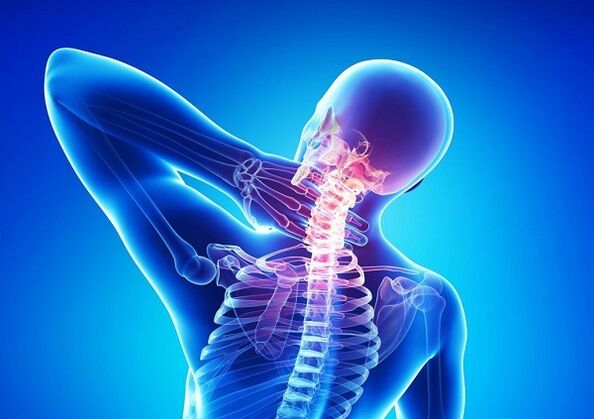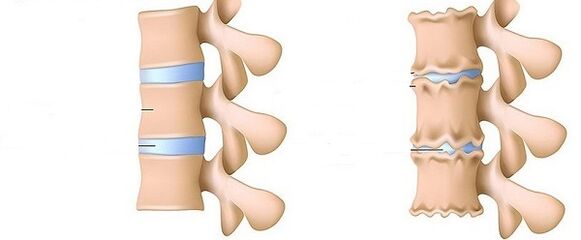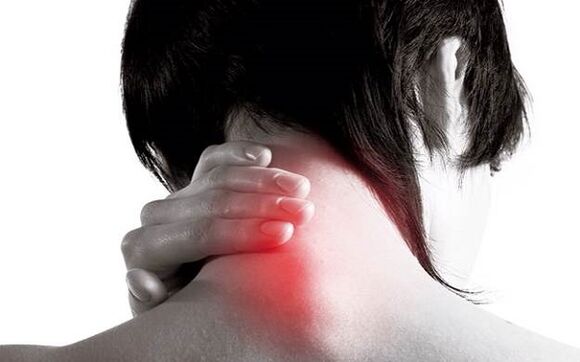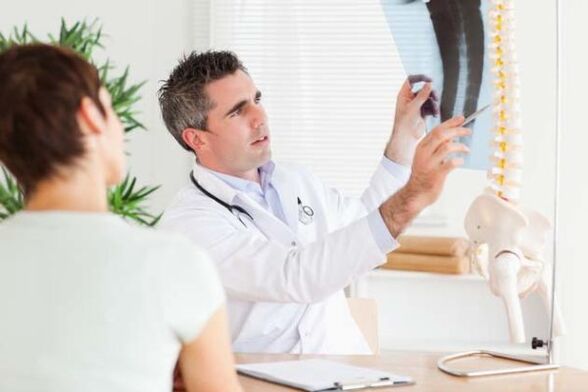Do you often experience pain in your neck and head, and does the pain radiate to your arm and shoulders? Maybe you have cervical osteochondrosis, which should be treated as soon as possible? How to diagnose the disease and which doctor to look for? And also how to provide first aid in neck osteochondrosis? Read about this and more later in this article.
Disease characteristics
For starters, let's remember what kind of disease it is. Therefore, osteochondrosis of the cervical vertebra is a disease of the intervertebral discs of the cervical spine, which are the most mobile. In most cases, the injury occurs at the level of vertebrae C5 - C7. Symptoms of the disease also depend on the affected vertebra. More on that later.

Reasons for Appearance
To understand how to treat cervical osteochondrosis, you must first understand what causes it to appear. For starters, let's say this disease is becoming more common lately. The risk zone in old age is 25 to 40 years. There can be many reasons for the illness. The most common are:
- working on the computer, as well as driving frequently and for a long time;
- inactivity;
- salt accumulation in the cervical spine;
- impaired metabolism;
- Poor nutrition;
- neck injuries;
- rheumatism;
- heredity;
- hormonal disturbances;
- severe hypothermia, etc.

Symptoms
The disease has several symptoms that can manifest themselves either together or separately. It all depends on the affected area of the neck. So, to know how to treat osteochondrosis of the cervical spine, you need to know what is affected and what the consequences might be. First, consider the general signs of cervical osteochondrosis.
- Ache. Pain syndrome is seen in the neck, back of the neck and shoulders. Also, pain can be applied to the hand. This disease is responsible for 30% of all headaches. All due to the fact that with osteochondrosis, blood vessels can be pinched. Thus, the blood flow to the brain decreases and there are severe headaches, accompanied by rapid fatigue.
- Crunch. When turning the head and tilting it, there is a strong characteristic click.
- Numbness. It can occur in the shoulder blade region, accompanied by strong "lumbago". Also, the neck itself may become numb, while there will be a noticeable unpleasant tingling sensation in the arm and leg area.
- Weakness and dizziness. On top of this, frequent fainting may occur, drowsiness may appear, and rapid general fatigue may be observed.

If you are treating cervical spine osteochondrosis at home, you still need to know how to accurately determine the area of injury. Here, you just need to know what the symptoms will be if one or another nerve root near the vertebra is affected. There are 8 of these processes in the cervical spine in total, and they are designated C1 - C8.
- C1 - with its defeat, the impaired sensitivity is observed in the occipital region.
- C2 - pains appear in the back of the neck and crown.
- C3 - the infraction is accompanied by severe pain in the place where it occurred. Neck sensitivity decreases. The taste sensitivity of the tongue is impaired. Speech problems can occur.
- C4 - pain in the liver and heart. There is also numbness and pain in the shoulders and between the shoulder blades.
- C5 - pain and decreased sensation in the upper part of the shoulder.
- C6 - very painful area including neck and shoulder blades. The pain spreads to the shoulder and radiates up the arm, reaching the thumb of the hand.
- C7 - the symptoms are similar to those of C6, but the pain spreads to the back of the shoulder and to the entire arm, affecting the other fingers, except the little finger.
- C8 - similar to C7. In addition, numbness and pain already reach the little finger.
Types
Are you wondering if it is possible to cure osteochondrosis of the cervical spine at home? Next, you need to find out what stage of the disease you have. After all, only the first degree of treatment can be done at home. In total, 3 grades of the disease can be distinguished on the basis of their progression.
Where to go for help?
So, you have some signs of the disease and you have decided not to sit still, but to ask a specialist for help. The question is brewing: "Which doctor treats cervical osteochondrosis? "Well, it all depends on what stage of the disease you have. Thus, the treatment of 1st degree ulcers can be performed by a specialist in therapeutic gymnastics or a massage therapist. This also includes alternative medicine, meaning a direction like osteopathy.
2nd degree osteochondrosis of the cervical spine already requires observation by a physician in a polyclinic. Here, physiotherapists or manual reflex therapists can deal with the wound. Furthermore, it will not be superfluous to consult a neurologist. Grade 3 cervical osteochondrosis requires more professional medical treatment. Here, a neurologist must initially deal with the disease, as there are some nerve endings in the cervical spine. In an advanced case, the surgeon treats osteochondrosis of the cervical spine together with a neuropathologist.

Diagnosis
Before treating neck osteochondrosis, you will need to have a test done. The attending physician will palpate your neck, perform various manipulations, and question you. Be sure to prescribe an X-ray of the cervical crest. Also, a general blood test will be prescribed. For a more detailed understanding of the disease, they can be sent for an MRI or CT scan.
How is the treatment done?
To begin with, let's answer the question: "Is it possible to cure cervical osteochondrosis? "Yes, it is possible, but it is possible to fully face the disease only in the early stages. So how to defeat cervical osteochondrosis? There are different treatments for this, which are described below.
medicine
Medications are the most effective methods of treating 2nd and 3rd degree cervical osteochondrosis. Complex treatment is performed here. Therefore, some medications should alleviate the pain that plagued you. Other medications fight inflammation. Still others - relieve swelling, the fourth remedies restore blood circulation and supply nutrients to the diseased area. All of them can be in the form of pills and in the form of injections and injections. With osteochondrosis of the cervical spine, ointments will be ineffective.

The entire treatment of cervical osteochondrosis in women and men is divided into 3 stages.
As you were tortured by osteochondrosis and decided to go to the hospital, please do not self-medicate and follow all your doctor's instructions.
Physiotherapy
Physical therapy can answer how to cure osteochondrosis of the cervical spine. The most commonly used methods are:
- magnetotherapy;
- electrotherapy;
- laser treatment;
- UFO;
- balneotherapy others.
Surgical intervention
Sometimes only a surgeon can answer how to get rid of cervical osteochondrosis. The operation is scheduled after consultation with a neurologist. Here, the surgeon must try his hardest to make the osteochondrosis that defeated him recede. After surgery, be prepared for a long course of recovery.
ethnoscience
And what will folk medicine say to all this? There are sufficient methods and means for treating such a disease. However, remember that you act at your own risk and risk, so you alone are responsible for the consequences. So how to deal with osteochondrosis using folk remedies.
- The first method consists of swabs for cervical osteochondrosis in Indian onion leaf. To do this, you need to take a leaf from the plant and rub the diseased areas with it, then apply the leftovers as a compress overnight. The curative effect should be observed the next morning.
- Another evening compress is made with cottage cheese sprinkled with vinegar. It is done several nights in a row until the treated effect appears.
- Horseradish leaves are used in a similar way. We take a leaf from a newly harvested plant, rinse it in boiling water and apply it to a sore spot overnight, having previously wrapped it with something warm.
- How to cure cervical osteochondrosis with a shovel? And here everything is quite simple. The fact is, we don't need the entire shovel, but only a part of it, called a three-foot-long handle. To make it a miracle drug, you need to take it with both hands and wrap it around your neck. Also, with up and down movements, we massage the diseased areas. The procedure must be done several times a day, for at least a week.

Contraindications to treatment
Sometimes a difficult question arises: "What can you do with cervical osteochondrosis and what can't? "It turns out that not all medical procedures always have a therapeutic effect only. Sometimes they can be very harmful to the patient. Therefore, it is worth dealing only with the recommendations of the treating physician. Therefore, this includes the following procedures that are used to treat osteochondrosis:
Having acupuncture for osteochondrosis is contraindicated if you are 75 years of age or older, as well as for pregnant women. The remaining contraindication points for this procedure are identical to massage. That includes:
Exercise therapy or physiotherapy complex, with a disease such as osteochondrosis, also has contraindications. The most common are unhealed injuries, bruises and severe bruises. Also contraindications here include:
- an acute exacerbation of the disease;
- weak heart;
- manifestation of tachycardia or arrhythmia;
- severe forms of diabetes;
- tendency to bleed;
- infectious wounds;
- there are diseases associated with the vestibular system;
- having vision problems;
- neurological symptoms that lead to loss of coordination.
How to provide first aid?
If osteochondrosis caught you by surprise at home, first aid will be as follows:
















